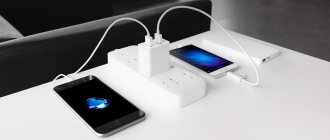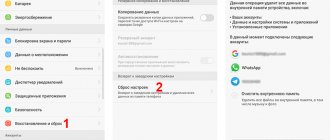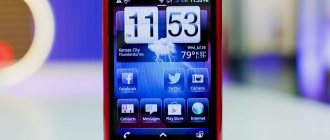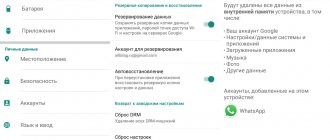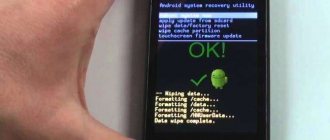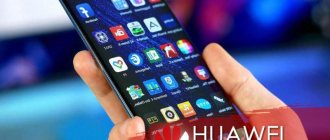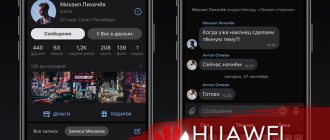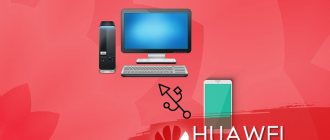Busting charging myths
Below we will look at the 4 most common questions about charging batteries.
Myth No. 1. Don't leave your phone plugged in to charge all night
This opinion was formed due to old devices that heated up and could fail. However, manufacturers have long ago solved this problem. A smartphone connected to the network automatically stops receiving power when the battery indicator reaches 100%.
Myth No. 2. You can only charge a completely discharged battery
This misconception also came from older devices that used nickel-containing batteries with the “ Memory Effect ”. All modern devices use lithium polymer batteries and can be charged at any time.
Myth No. 3. Fast charging harms your smartphone
It is not Quick Charge technology that is harmful, but its frequent use. In modern realities, people do not always have the time and patience to leave the phone connected to an outlet for a full charging cycle. They prefer to connect the device to the network several times during the day for short periods of time. But lithium polymer batteries have a certain number of charge cycles, after which their capacity begins to decline. Therefore, it is recommended to perform fast charging infrequently.
Myth No. 4. A new phone needs to be completely discharged and charged several times.
This opinion has been around for a long time, but progress does not stand still. Previously, nickel batteries were used, for which this rule was relevant. You can charge a new phone with lithium batteries based on other rules, which will be discussed later in this article.
Types of batteries
In phones that have been produced over the past few years, there are two types of batteries:
- lithium-ion;
- lithium polymer.
The first type is lithium-ion (Li-ion). They are often used on laptops and smartphones.
This is because the settings create high offline performance for the device. These batteries are based on a carbon matrix, which is made from graphite. Among the advantages of this type:
- high service life in different devices due to high-quality mechanism;
- the product weighs a little;
- has high energy density;
- charge quickly.
The lithium polymer type of battery is used somewhat less frequently.
But in fact, this is a more modern version of the ionic type. It is based on polymer substances, which allows you to quickly charge devices. Among the obvious disadvantages is the high risk of fire in case of overheating. This applies to all types of batteries.
Why does my phone battery drain quickly?
Consider the most common reasons.
- Large screen , which requires more electricity to display, which means the battery will drain faster.
- Screen brightness also affects how long the battery will last. Manually reducing the brightness level or turning on automatic mode will increase the operating time of the phone. Turning on dark mode can partially solve this problem.
- Loading the processor during games and using applications greatly drains the battery. Heating or overcooling the device also has a negative effect.
- Work of background processes such as Bluetooth, mobile Internet, Wi-Fi, GPS, Google services and others. They should be disabled if they are not currently needed.
- Large number of charging cycles . Over time, any smartphone discharges faster and there is no way to avoid this. But following certain rules, which will be described below, you can extend the battery life.
Charge your gadget halfway if you plan not to use it for a long time
Let's say you're leaving home for a month or two and don't want to take all your gadgets with you. Then you need to properly prepare them for inactivity. Apple and other manufacturers recommend turning off devices in such cases, leaving about 50% charge in the battery.
The operating principle of lithium-ion batteries is based on the movement of lithium ions between positively and negatively charged electrodes through an electrolyte. I would like this process to last forever, but everything in this world is subject to aging, and in the case of batteries, degradation. If human life is measured in years and decades, then the concept of the number of charge/discharge cycles is more suitable for assessing the longevity of batteries. How to extend the life of your smartphone’s battery and what is the “sweet spot”? Let's explain.
The charge/discharge cycle has no clear boundaries, the depth of charge and discharge may vary, and the number of cycles may be reduced or increased depending on the intensity of use and the conditions under which the battery operates. Therefore, putting a fitness stamp on such devices is a thankless task. A resourceful user will always find a way to kill the battery ahead of schedule.
Almost three decades have passed since Sony released the first lithium-ion battery. And if during this time processors increased their power every two years according to Moore’s law, doubling the number of transistors, then batteries increased in capacity every year by about 8%. Fortunately, the cost of their production decreased at approximately the same rate. Today, lithium-ion batteries meet most of the expectations of the mainstream device market, even if consumers complain about low capacity and the need for frequent charging. Believe me, this is the best we have for mobile technology so far.
Here are some tips on how to handle this “best”.
Charging rules for Honor and Huawei smartphones
Let's look at how to properly charge Honor and Huawei so that the device can function for as long as possible.
How to charge a new phone
If you have a new device from Huawei, then contrary to popular belief, you should not wait until it is completely discharged. New devices require downloading updates and installing applications. Therefore, as soon as the device is removed from the box, it is recommended to connect it to the network and wait until the charge indicator reaches 100%. After this, you can install updates, download games and applications.
Everyday exercise
All subsequent charging of Huawei phones and tablets can be carried out at your convenience. It is recommended not to wait until the device is completely discharged and when the battery level is 10-15% , connect it to the network.
Battery calibration
Due to frequent loads and the fact that the smartphone is constantly turned on, the battery capacity may decrease. Calibration will help fix this. This process consists of the following steps:
- Completely discharge the battery to 0%.
- Connect the switched off smartphone to the network (it is recommended to use the original power adapter).
- Wait until it is fully charged to 100%.
- Enable and use.
It is recommended to carry out calibration every 1.5-2 months.
Tips on how to keep your battery stable
Of course, we would all like our phone battery to last forever and not break. But, alas, such a perpetual motion machine has not yet been invented. Don’t rush to get upset, because elgreloo.com has put together several recommendations for you that will help keep your battery healthy and prevent premature failure.
- Do not discharge your smartphone to zero.
- Do not overload the battery.
- Do not allow the battery to become too cold or overheated. This can dramatically reduce the battery charge, or even break the battery.
- Don't charge your phone to 100%.
- Do not leave your smartphone connected to the charger after it is fully charged.
- Once a month you can do a training session for the battery, completely discharge it, and then charge it to 100%. This will calibrate your device and the charge level will be displayed more accurately.
- Disable geolocation, mobile Internet, Wi-Fi and other functions and applications if you do not use them.
- Try to keep the charge level between 20-80%. If you charge your phone several times a day, this will not harm it, but on the contrary will help increase the battery life.
- Use only original chargers. If your cable is broken/lost/stolen, then do not use the cord from your old smartphone, do not borrow from friends, but buy a new one.
These are not all the ways you can save your battery. If you want to know more about this, go to our article:
Follow these tips and your smartphone will last you much longer. We hope that these recommendations from elgreloo.com will help you. Good luck!
What to do if your Huawei or Honor phone is not charging
The problem with charging a Huawei or Honor smartphone can be caused by the following main reasons :
- the electricity in the network is turned off;
- faulty socket;
- the charger or cable is damaged;
- damage to the micro USB or USB-C socket on the device itself;
- the current-carrying cable or contacts have failed;
- malfunction of the device;
- presence of viruses;
- The battery has failed.
If you are faced with such a problem and do not know what to do if your smartphone does not charge, then it is recommended to take the faulty device to a service center. But before that, check if the charge is coming from another charger.
We recommend that you familiarize yourself with the proprietary Huawei HiCare application, with which you can contact the official support service.
Types of batteries in smartphones
To begin with, it’s worth saying a few words about the types of batteries used in phones. Modern smartphones use lithium-ion (Li-Ion) and lithium-polymer (Li-Pol) batteries. What are these devices?
Lithium-ion batteries have entered consumer electronics, displacing nickel-cadmium and nickel-metal hydride batteries. Lithium-ion batteries were superior in their characteristics to the above alkaline batteries with the exception of discharge current. Their value is significantly lower. But since this is not so important in smartphones, tablets and laptops, lithium batteries have firmly occupied this niche.
In lithium batteries, the main problem was the use of lithium electrodes. Due to lithium's instability, it has been impossible to create a safe energy source for consumer devices. Therefore, manufacturers began to develop electrodes not from lithium, but from its various compounds. And with a slight loss of energy density, they managed to create batteries with the required characteristics.
We recommend that you additionally read the article on how to properly charge a li-polymer battery. This is how lithium-ion batteries with a negative electrode made of carbon materials were developed. Cobalt oxides began to be used as the active mass of the positive electrode. This material has a potential of 4 volts relative to the carbon electrode in which the lithium is intercalated. Therefore, most lithium-ion batteries have a voltage of 3-4 volts. During the discharge process of a lithium-ion battery, deintercalation of Li from the carbon material occurs on the negative electrode. At the positive electrode, lithium intercalates into the oxide. When the battery is charged, this process goes in the opposite direction. There is no metallic Li in the system. The charge-discharge process is the transfer of Li ions between electrodes. They even became known as “rocking chair” batteries.
Smartphones also use lithium-polymer batteries (Li-Pol). They are based on the transition of polymers into semiconductors. This occurs when electrolyte ions are introduced into their structure. As a result of this process, the conductivity of the polymer material increases significantly. Scientists are working towards finding a polymer material that would replace the liquid electrolyte. Such searches are being carried out both for Li-Ion batteries and for batteries with metallic Li. For the latter, if a polymer electrolyte is used, the energy density can increase several times compared to lithium-ion ones. Currently, battery manufacturers have already mastered the serial production of the following types of lithium batteries:
- polymer electrolytes in which lithium salts are embedded. This may not be one polymer, but a mixture;
- dry polymer-based electrolytes. Mostly it is polyethylene oxide with various lithium salts;
- microporous matrices into which non-aqueous solutions of lithium salts are embedded.
We also recommend reading about how to charge your phone battery without a phone.
Answers to popular questions
Is wireless charging harmful?
According to recent studies, wireless charging does not have any harmful effects on either the person or the device being charged. In addition, this technology is becoming more popular and improving. Therefore, every year there are more and more smartphone models that can be charged without standard charging.
How often can a phone be charged using an external battery?
PowerBank does not cause any harm to the battery. You can charge a Huawei or Honor smartphone from it an unlimited number of times.
Do I need to discharge the battery to zero and charge it to 100%?
Not worth it. Most mobile devices turn off when the charge level reaches 3 volts per cell. Or approximately 5% of the remaining actual battery capacity, even if it is already 0% in the system. Manufacturers choose this threshold in order to reserve charge for servicing the controllers, reduce the load on the battery, and also in case the phone is not immediately connected to the charger. So that there is a reserve in case of passive self-discharge. This process can take months until the voltage drops to 2.5 volts per cell. After this, the protective circuit will open and the battery will begin to fail.
In industrial devices, this residual charge threshold may be higher, since the goal there is to extend the service life of the tool. Their batteries can operate in the so-called sweet zone (30 to 80% of actual capacity), as this provides the longest service life. This is not being implemented in the consumer smartphone market, because we are primarily faced with the issue of comfort. Is it worth thinking about sweet spots if most people change their phones every 3-5 years?
Find the sweet spot on the chart
Advice to discharge your phone to zero has been around since the days when nickel-cadmium and nickel-metal hydride batteries were in common use. They have the so-called memory effect - loss of capacity if the battery has not been completely discharged and a new charging cycle has already started. Lithium-ion batteries do not experience this effect; they can be recharged at any time. Just decide for yourself the “sweet zone” and comfort.
Do I need to completely discharge my smartphone?
If the user often completely discharges his smartphone to 0%, then such actions reduce the battery life. In regular situations like this, the battery will not always be able to reach 350 full cycles when charged from 0 to 100%.
In order to increase the life of the lithium-ion battery, the user needs to charge the smartphone before the charge drops below 40%. In this case, the service life of the battery will be extended.
Honor specialists believe that the charge should not fall below 20%, therefore in such situations a system message indicating a low charge level is displayed on the mobile device. Thus, it is preferable to discharge the phone a little, for example to half the charge level. This way the work will be more efficient. Share link:
There are many opinions about how to charge electronic devices. Certain rules for charging a smartphone have long been ingrained in people’s minds. But some of them are irrelevant for modern mobile devices, while others are generally myths , following which you can harm the device’s battery and reduce its operating time and autonomy. It's time to talk about how to properly charge Honor and Huawei phones, what you shouldn't do to avoid harming the battery, and how to extend its life.
Page navigation:
